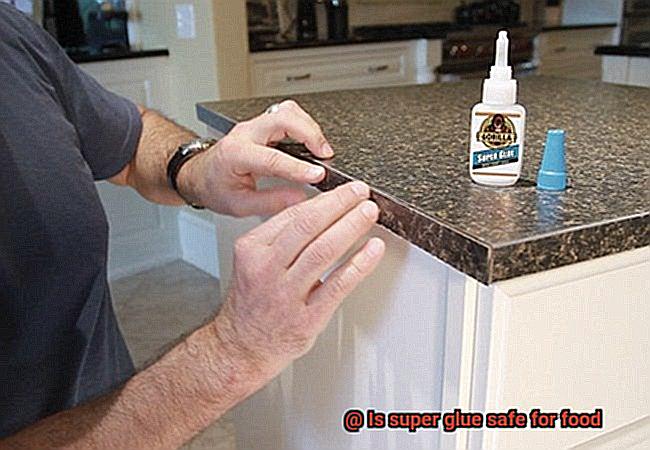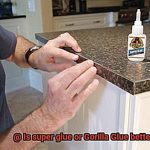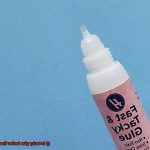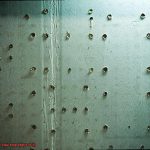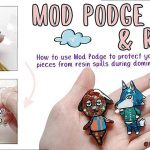Today, we’re tackling a question that’s been buzzing around in our minds: Is super glue safe for food? Picture this: you’re on the brink of despair as your favorite coffee mug shatters into a million pieces or your delicate plate cracks like a spiderweb.
In that moment of desperation, have you ever considered reaching for that trusty tube of super glue lurking in your toolbox? Well, hold your horses.
Before you take the plunge, let’s take a moment to ponder the potential risks and consequences of using this mighty adhesive on items that come into contact with our precious meals. Get ready to dive deep into the facts, dissect the science, and uncover whether super glue and food can actually play nice together.
Buckle up, buttercup – it’s time to get stuck into this sticky situation.
Potential Health Risks of Using Super Glue on Food
Contents
- 1 Potential Health Risks of Using Super Glue on Food
- 2 The Unsafe Nature of Super Glue
- 3 FDA Regulations on Super Glue and Food Contact
- 4 Alternatives to Using Super Glue on Food Items
- 5 Types of Food-Grade Adhesives
- 6 Safety Tips for Using Adhesives in the Kitchen
- 7 What to Do if Accidentally Ingesting Super Glue?
- 8 Conclusion
Ensuring food safety should always be a top priority. While super glue may be a versatile adhesive for household repairs, using it on food can have serious health implications. This article aims to explore the potential dangers associated with using super glue on food and why it should never be used in such a manner.
Chemical Leaching:
One of the primary concerns when using super glue on food is the risk of chemical leaching. Super glue contains chemicals that can seep into the food, especially when exposed to heat or moisture. This ingestion of harmful substances can result in gastrointestinal issues and other health problems.
Toxic Fumes:
It is important to note that super glue releases toxic fumes when heated, which can contaminate the food and pose a significant risk if inhaled. Ingesting these chemicals may lead to irritation of the gastrointestinal tract, nausea, vomiting, and in severe cases, even more serious symptoms.
Allergic Reactions:
Super glue contains chemicals that may trigger allergic reactions in hypersensitive or allergic individuals. Direct contact with super glue on food can cause skin rashes, itching, redness, swelling, and difficulty breathing. It is essential to remember that everyone’s body reacts differently, so what might be safe for one person could be harmful to another.
Lack of Regulatory Approval:
It is worth noting that super glue is not regulated or approved by regulatory bodies like the FDA for direct contact with food. The FDA strictly regulates materials that come into contact with food to ensure their safety. Since super glue does not meet these safety standards, it should never be used on food items.
Long-Term Health Implications:
Continuous exposure to the chemicals present in super glue can accumulate in the body over time and potentially lead to chronic health issues. Prioritizing food safety and avoiding any potential risks associated with using super glue on food is crucial for maintaining long-term health.
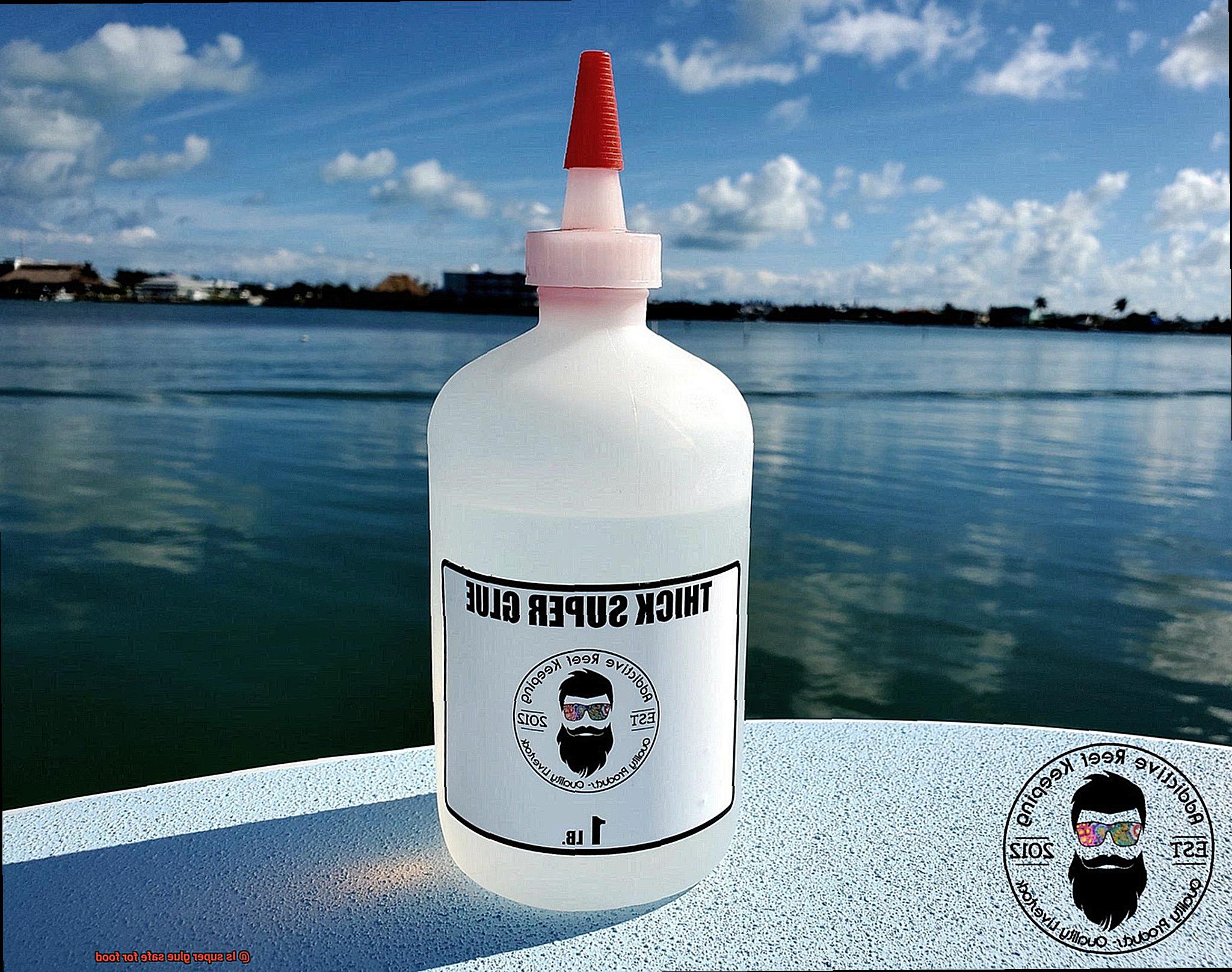
The Unsafe Nature of Super Glue
Super glue, also known as cyanoacrylate adhesive, is a popular adhesive used for various purposes. However, when it comes to using super glue with food, caution is necessary. The chemicals present in super glue can pose serious health risks if ingested. Let’s delve into the unsafe nature of this adhesive.
One of the toxic substances found in super glue is formaldehyde. This known carcinogen is commonly used as a preservative and disinfectant. Ingesting formaldehyde through super glue-contaminated food can lead to unpleasant symptoms like nausea, vomiting, and abdominal pain. Moreover, long-term effects can include organ damage and an increased risk of cancer.
Another harmful chemical found in super glue is acetic acid, which is commonly found in vinegar. While acetic acid itself may not be highly toxic, consuming large amounts of it can cause stomach pain, diarrhea, and vomiting. Clearly, an experience resembling vinegar is not what you want when enjoying a meal.
Aside from the chemical risks, the fast-hardening nature of super glue can also be hazardous. Imagine accidentally swallowing a piece of super glue along with your meal – a choking hazard that could have serious consequences.
Luckily, there are safe alternatives available. Food-grade adhesives are specifically formulated to be consumed safely and comply with strict regulations set by food safety authorities. When working with food items, it is important to use these specialized adhesives to ensure the safety of consumers.
FDA Regulations on Super Glue and Food Contact
The FDA, our trusted regulatory agency, has specific guidelines in place to ensure the safety of materials used in food contact applications. According to their regulations, substances that can migrate from packaging materials into food should be safe for their intended use and not pose any risk to human health. This means that when it comes to super glue, the FDA does not specifically regulate its use in food contact applications because it is not intended or approved for such use.
But don’t fret, my friends. There are alternatives out there specifically formulated and approved for use with food. These food-grade adhesives are like superheroes when it comes to keeping your culinary creations intact without putting your health at risk. So next time you’re faced with a broken plate or a loose handle on your favorite mug, reach for these safe alternatives instead.
However, before you rush out to buy any old adhesive claiming to be “food-safe,” remember to always check the packaging and labels. Just because a product is labeled as such doesn’t mean it’s been tested and approved by the FDA. It’s always better to be safe than sorry.
Alternatives to Using Super Glue on Food Items
When it comes to using glue on food items, safety should always be the top priority. While super glue may be tempting for its strong bonding powers, it is definitely not suitable for use on food. But fear not, my friends. There are plenty of alternatives out there that are safe and effective for all your culinary and crafting needs.
- Food-Grade Adhesives: These adhesives are specifically formulated for use in the food industry and are made from non-toxic materials. Perfect for sealing bags or containers, food-grade adhesives are commonly used in commercial kitchens and bakeries where keeping things sealed and fresh is a top priority.
- Edible Glue or Gum Paste Adhesive: If you’re into cake decorating or creating edible masterpieces, edible glue or gum paste adhesive is your new best friend. Made from ingredients like tylose powder or confectioner’s sugar mixed with water, these glues are safe to consume and can be used to attach decorations or assemble edible creations.
- Food-Safe Epoxy Adhesives: Designed for surfaces that come into indirect contact with food, such as kitchen utensils or cutting boards, these adhesives provide a strong bond while being resistant to moisture and heat. Perfect for all your kitchen needs.
- Royal Icing: For those feeling extra creative, royal icing can act as a strong and edible adhesive. Made from egg whites and powdered sugar, it can be used to build gingerbread houses or construct cake structures without any worries.
Types of Food-Grade Adhesives
The food industry is a delicate ecosystem where safety and quality are paramount. To ensure that our food remains secure and uncontaminated, the use of food-grade adhesives becomes essential. These specialized adhesives have been specifically formulated to comply with regulatory standards and are designed to be safe for direct contact with food. In this article, we will explore the different types of food-grade adhesives and their applications in the food industry, shedding light on their critical role in keeping our food safe and delicious.
Epoxy Adhesives: The Bonding Strength that Holds it All Together
Imagine a bustling food processing plant where conveyor belts transport mouthwatering treats from one station to another. The adhesive holding those belts intact and preventing contamination is epoxy adhesive. Known for its exceptional bonding strength, chemical resistance, and moisture resistance, epoxy adhesives ensure that food processing equipment, such as conveyor belts and packaging machinery, remains durable, reliable, and safe.
Cyanoacrylate Adhesive: The Super Glue that Dries in a Flash
Have you ever witnessed someone fixing broken pottery with super glue? Well, in the food industry, cyanoacrylate adhesive, also known as super glue, is utilized for bonding various materials. However, it is crucial to note that not all super glues are safe for direct contact with food. Only specially formulated food-grade cyanoacrylate adhesives should be used in food-related applications to guarantee our safety.
Silicone Adhesives: Sealing the Deal with Temperature Resistance
Visualize a bakery’s piping hot oven, where delectable goodies are baked to perfection. The seal that keeps the oven closed and prevents any leakage is made possible by silicone adhesives. These adhesives possess outstanding resistance to high temperatures, chemicals, and moisture. Perfect for sealing joints and gaps in food processing equipment like ovens, silicone adhesives ensure that no harmful substances find their way into our favorite treats.
Polyurethane Adhesives: Flexibility that Adapts to Every Situation
Envision stacks of cardboard boxes brimming with tantalizing chocolates, ready to be shipped worldwide. What keeps those boxes securely closed? Polyurethane adhesives rise to the occasion. With their perfect blend of flexibility and bonding strength, polyurethane adhesives are used for bonding packaging materials like cardboard or plastic. They also excel at sealing joints in food processing equipment. With polyurethane adhesives, our food remains protected and safely travels from one place to another.
Safety Tips for Using Adhesives in the Kitchen
Using adhesives in the kitchen can be helpful when repairing utensils, fixing broken items, or even creating fun DIY projects. However, it is crucial to prioritize safety when using adhesives in a food preparation area. This article will provide important safety tips for using adhesives in the kitchen.
Choose food-safe adhesives:
It is essential to select adhesives that are specifically labeled as food-safe or approved by the FDA. These adhesives are specially formulated to ensure they do not release any harmful chemicals or toxins when in contact with food. Look for certifications or labels on the adhesive packaging to ensure its safety for kitchen use.
Avoid using toxic adhesives:
Toxic adhesives can be dangerous, especially those containing harmful chemicals like formaldehyde or lead. These adhesives can release toxic fumes or substances that may contaminate food and pose health risks. Check the ingredients list and warnings on adhesive products to identify any potential hazards.
Proper ventilation:
Proper airflow is crucial when using adhesives in the kitchen. It helps dissipate any fumes or odors emitted by the adhesive, minimizing exposure to harmful substances. Open windows or use exhaust fans to enhance ventilation during adhesive application.
Follow instructions:
Read and follow the manufacturer’s instructions when using adhesives in the kitchen. Each adhesive may have specific guidelines regarding application, drying time, and safety precautions. Adhering to these instructions ensures safe usage and optimal performance of the adhesive.
Avoid direct contact with food:
Be cautious and avoid direct contact between adhesives and food items. Even food-safe adhesives are designed for bonding surfaces, not for direct consumption. Apply the adhesive on non-food contact areas and ensure it is fully cured or dried before using the item around food.
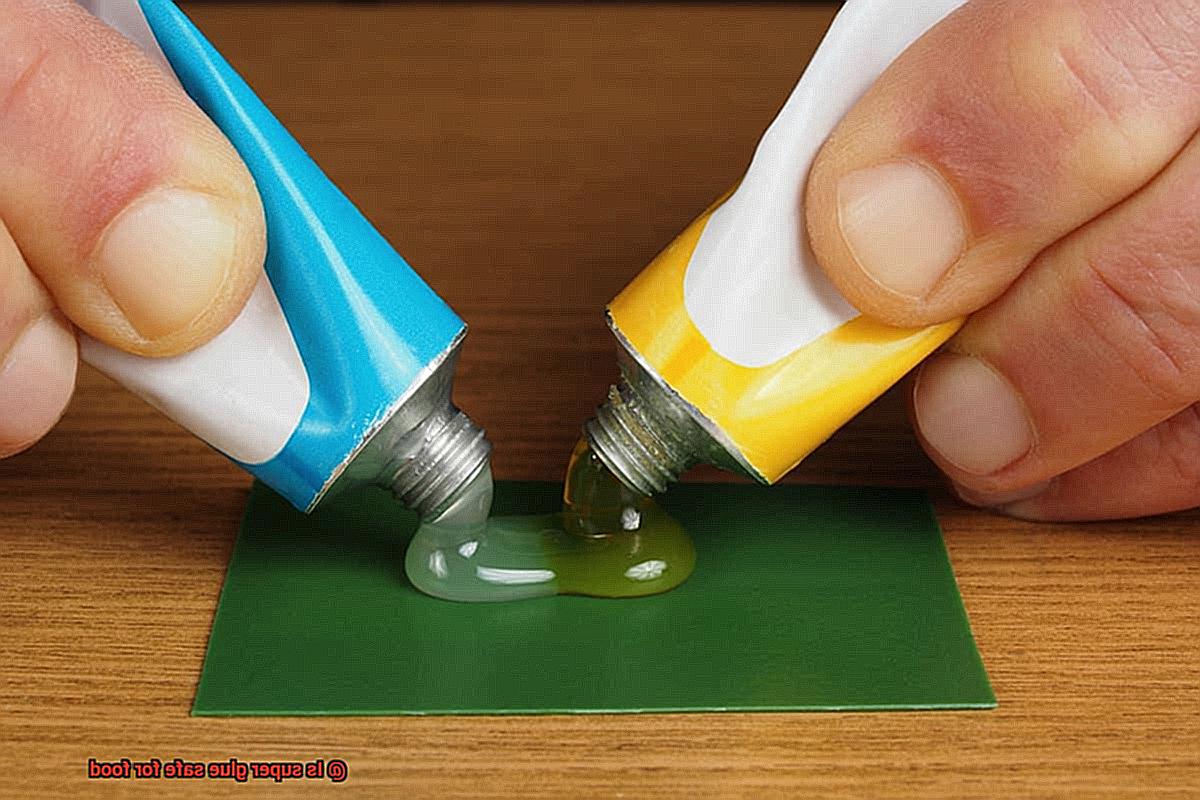
Proper storage:
Store adhesives properly to maintain their effectiveness and safety. Keep them in a cool, dry place away from direct sunlight and extreme temperatures. Ensure adhesive containers are securely closed after use to prevent accidental spills or exposure.
Cleanliness and hygiene:
Maintain a clean and hygienic workspace when using adhesives in the kitchen. Clean up spills or drips of adhesive promptly with appropriate cleaning agents. Remember to wash your hands thoroughly after handling adhesives to avoid transferring any residue onto food or utensils.
What to Do if Accidentally Ingesting Super Glue?
Accidentally ingesting super glue can be a worrisome situation, but don’t panic. Super glue is not meant to be consumed, and it can have harmful effects on the body. In this article, we will guide you on what to do if you accidentally ingest super glue and how to prevent such accidents in the future.
Stay Calm and Assess the Situation:
First things first, stay calm. Accidentally swallowing a small amount of super glue is usually not a serious emergency, but it’s crucial to take action for your safety. Assess the situation and determine the severity of ingestion.
Remove the Glue (If It’s Still in Your Mouth):
If the super glue is still in your mouth or throat, try to remove as much of it as possible by rinsing your mouth with warm water. This will help dilute the glue and prevent it from adhering to the inside of your mouth.
Drink Plenty of Water:
If you’ve already swallowed the super glue, don’t fret. Drinking plenty of water or any non-alcoholic beverage can help dilute the glue and facilitate its passage through your digestive system. Avoid milk or carbonated beverages, as they may cause discomfort.
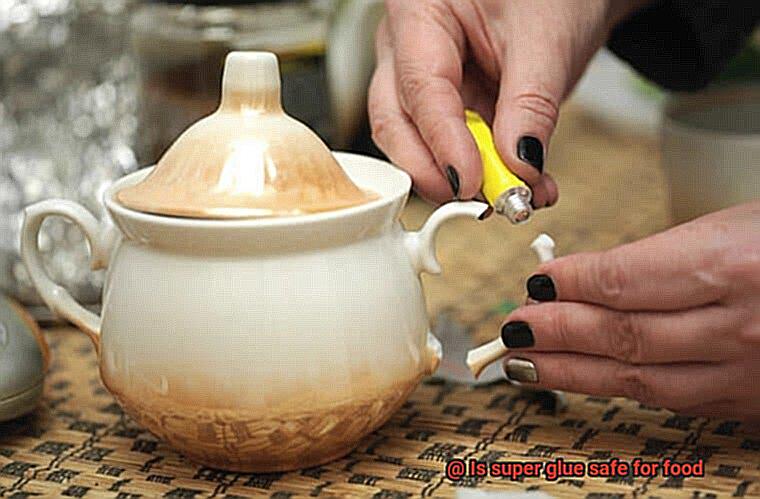
Monitor for Symptoms:
After ingesting super glue, keep an eye out for any symptoms or adverse effects. You may experience throat irritation, difficulty swallowing, or a mild upset stomach. These symptoms typically resolve on their own without specific treatment.
Seek Medical Attention (If Needed):
If more severe symptoms occur, such as persistent pain, difficulty breathing, or signs of an allergic reaction like swelling or hives, seek immediate medical attention. Inform healthcare professionals about the accidental ingestion so they can provide appropriate treatment.
KxCBENKD9XQ” >
Also Read: Is Glue Edible? – Glue Things
Conclusion
In conclusion, it is abundantly clear that super glue and food do not mix. Using super glue on your meals is a recipe for disaster that should be avoided like the plague. The potential health risks lurking beneath the surface are nothing short of alarming.
One of the biggest concerns when it comes to using super glue on food is chemical leaching. Those pesky chemicals in super glue have a sneaky way of seeping into your food, especially when heat or moisture is involved. This infiltration can wreak havoc on your gastrointestinal system and lead to a whole host of health problems. And let’s not forget about those toxic fumes that waft into the air when you heat up your glued-up dish. Inhaling them can spell trouble for your well-being.
Allergic reactions are another terrifying danger posed by using super glue on food. If you happen to be one of those unlucky hypersensitive or allergic individuals, direct contact with super glue could unleash a world of skin rashes, itching, redness, swelling, and even difficulty breathing. It’s like playing Russian roulette with your immune system.
To make matters worse, super glue doesn’t have the stamp of approval from regulatory bodies like the FDA for food contact. The FDA takes its job seriously when it comes to ensuring our safety around anything edible. Since super glue fails to meet their stringent standards, it has no business being near our precious meals.
Don’t fret though. There are plenty of alternatives out there that are specifically formulated and approved for use with food. Whether it’s food-grade adhesives, edible glues or gum paste adhesives, or even food-safe epoxy adhesives – these options have got your culinary needs covered.
To sum it all up: prioritize your health and safeguard the sanctity of your meals by banishing super glue from any item that dares to touch your food. Opt for safe alternatives that were born to mingle with edibles.

